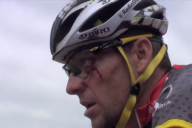Doping enforcement efforts, as currently structured, have failed at regular intervals in the past and will continue to fail in the future because of you.
It’s not that you don’t care enough about doping. You care plenty, so much so that it’s become counterproductive. We – well, you, anyhow – are helping to aim anti-doping efforts at the wrong people and it’s screwing things up. Hey you – quit picking on the riders!
Let me explain what I mean. As fans, we all fall in love with riders. We feel much closer to them than we really are, and because of this their victories make us delirious, their losses make us sad. And when they get popped for doping, we lose our minds, as if we’d caught our best friend and our significant other having sex atop our new bike. How dare they touch that bike!
Oh boy, do we fans ever head down some rabbit holes in pursuit of dopers. We conclude a guy is juiced because on his best day in a particular race, he rode a faster net time up a hill than a doper did on the same hill, more or less, 7 years ago. We condemn an anti-dope crusader because 17 years ago, before he put in 12 years of anti-doping work, he doped too. We conclude that the top 12 guys in this year’s USA Pro Challenge must be doped because they rode up a hill faster than Andy Hampsten did twenty-some years ago in the era of the patented “Ride Lots” training program. It’s like we hate bike racing or something.
Don’t get me wrong. Holding riders accountable for doping is a good thing and it is and will remain essential to enforcement efforts. Riders are moral agents, after all and responsible for their choices. (Well, except Hinault, who is a Fully Automated One Man Hippie Punching Machine Who Cannot Be Stopped). Racers get laurels and benefit mightily when they win, and deserve a commensurate share of the blame when they lose, and when they dope they should be held responsible. But pinning all the blame on them is a mistake because many people benefit far more from their doping, and focusing only on the riders allows the other conspirators to escape. And it’s your fault, tifosi. Cycling leadership is just doing what you asked, by punishing the dopers.
Please understand, pro bike racing isn’t really about bike races. It’s about making money. As in any other sport, teams and promoters can only make money in one of two ways: venue operations, and marketing. Venue operations involve ticket sales, parking, souvenirs, and vending – not very lucrative stuff in cycling. Marketing involves selling advertisement space, television rights, and other activities that put sponsor names in front of your eyeballs – and that is lucrative. Actual bike racing is almost incidental to The Business of Bike Racing. For all many sponsors care, bike racing might as well be NASCAR. What matters to them is that their logo and name are in front of you when you are having a good time watching your favorite pro kicking ass, and that when you see their product in the store, you get a warm feeling you can’t explain, and plunk down cash for it.
I will give you an example. I was a casual fan of bike racing for much of the 80’s and 90’s, but one thing I remember is that Mapei fielded some spectacular classics teams and scored some nice sprint wins in grand tours. A few years back – about 5 years after Mapei stopped sponsoring the top levels of the sport – I was hunting for some adhesive to lock down some bathroom tiles in a home renovation project. What should I see on the shelf, but Mapei brand mastic! I was actually looking for the equivalent 3M product, but decided I would at least give the Mapei a try because they sponsor the sport, and hey, Museeuw and Tafi. It had nothing to do with the quality of the product. In fact, when I researched it later, I figured out that a lot of the Mapei products are probably aimed at a low end to midrange market and not really suitable for my bathroom. But Johann Museeuw got me to look.
You (along with a wider viewership) are the target of this marketing. Viewers are worth money to sponsors. This is why the starting and finishing chutes are bedecked with sponsor logos, why logos line key spots in the road (and get painted on the road), and why rider jerseys look similar to NASCAR race car hoods. Marketing also dictates race strategy sometimes. A weak team may have no hope for a win, but putting a rider into a small break where his name along with the primary team sponsor get mentioned every two minutes is worth a lot to a sponsor.
A racing team may introduce you to a brand and make its name stick in your head. You may not know what Argos is, but by God, after the 2013 Giro and TdF, you know it goes together with Shimano thanks to John Degenkolb and Marcel Kittel. Every time Kittel picked up green jersey points or won a stage, you saw the Argos logo and name. Every time Kittel got into a leadout train or the laughing group with Cavendish, you heard Argos. And every time he won and stood on the top step of the podium, and you saw the logo, Argos benefitted. When you go to tank up, if there is a Texaco on one side of the street and an Argos station on the other, assuming equal prices, which would you be more inclined to patronize?
I’m not saying Kittle Kittel doped, just illustrating how sponsors are fighting for your attention and ultimately your dollar. The more of your attention they win, the more likely they will win your dollars too. Winning races (and other strong performances, like animating a day-long breakaway) is what pays off for a sponsor. So in the end, like it or not, the sponsors are the ones who benefit most from doping. It’s not that they are directly encouraging doping; it’s that winning is worth so much to them, and doping so remote in its negative consequences, that they have no incentive to step up and make it clear that doping won’t be tolerated.
It would be very hard getting national sanctioning bodies to suspend whole teams and their sponsors as a punishment for (and deterrent to) doping. The UCI seems to have its hands full simply defining what it means for a bike to be a legal time trial bike. Getting it to settle on a corporate anti-doping enforcement policy, given all the political and financial conflicts of interest in the sport, is highly unlikely.
No, it’s up to us. We have to fight the doping. I think we have the power to do so, to move that needle a bit. Among our most effective weapons are belly-aching, and an almost fanatical devotion to gear. Seriously.
We have a more powerful weapon than the corporations do.
Social media.
You are very 1990s if you think we need to have television commentators and newspapers and the police on our side. Social media doesn’t render them completely irrelevant, but it diminishes their importance and gives us fans a seat at the table. Admittedly, sitting in your underwear in your mom’s basement spouting off about dopers isn’t going to move the public debate very much. But if a lot of us talk about it, and make a concerted effort link the dopers to their teams and their sponsors, wouldn’t the association of doper + team + sponsor start to take hold in the public’s imagination?
It’s not an entirely stupid theory and it is likely to make corporate marketers fearful. We’ve all seen how any social media meme with a tiny whiff of substance takes off like wildfire. Corporations are aware of this too, and that’s why they employ social media consultants. Those consultants monitor the temperature of conversations about the company, work on counter-messaging, or just as often weigh in on social media when they think they can put out an imminent brushfire. Just as companies spend a lot of money to build positive associations, they exert a lot of efforts to preserve their good image and to prevent negative associations from developing.
I doubt that any major corporations encourage teams and riders to dope. Instead, many corporate sponsors of cycling seem to tolerate doping as something that just comes with the sport. They live with it, like everybody else. But what they won’t and can’t tolerate is a rider who gets caught doping, one who drags the company name through the mud.
My mud-slinging friends: we do not need to resort to search engine chicanery, dishonesty or invective to get corporations to respond and exercise their power to clean up the sport. We do not even have to sling mud. What we need to do is simply speak the truth in our many social media communications, and link the dopers and their teams to the companies that sponsor them. Don’t mention the rider who was caught doping, without mentioning the top line sponsors of his (or her) team, and link to the corporate social media addresses such as Twitter handles. Facebookers can Facebook it, Twitterers can tweet it, and those on Tumbl’r can do whatever it is you do on Tumbl’r. Don’t exaggerate and assume a preliminary result means doping, or that a guy’s fast time up a hill means he doped. But do this honestly, and do it relentlessly.
And, if we discover doping that occurred in the distant past, don’t be too tough on the doper’s sponsors from back-in-the-day. But it’s fair to ask, “In light of the Giuseppe Narcotico revelations this week, what is Bike Company X doing to ensure that their sponsored riders avoid doping today?”
It is *that* simple. Well, sort of. A lot of us have to do it for this tactic to work. But if a lot of us do, then search engines and corporate desire for public good will should do most of the rest of the work for us.
If enough of us do this consistently, there will be a reaction. Most corporate sponsors of pro cycling will probably just track the uproar at first and give the appearance of ignoring it. Then, if an uproar has some legs, they may weigh in and try to do some crisis management. After a while, if a crisis about a doper seems to be enduring, corporate leadership will likely demand the sponsored team take action to mitigate the crisis and then discuss severing relations – either the doper’s relationship with the team, or the sponsor’s relationship with the team. Companies whose products are primarily outside of bicycling may well walk away. Those who sell to cyclists are more likely to stick around, and therefore more likely to take action.
The other tactic we can use is to organize good old fashioned boycotts. These don’t have much of a chance of succeeding with “big boy” sponsors – banks, phone companies and the like. Who cares if a few cyclists boycott a Fortune 500 company?
But bike industry corporations “race what they sell and sell what they race.” They are much smaller and more easily affected by social media efforts. They can’t simply walk away from racing, not without causing damage to their sales numbers and long term commercial prospects. For a bike industry company, the attraction of sponsoring a successful Pro team is that the marketing takes no effort – just put Victor Velo on the podium, and the racing fans will clamor to buy the bike, the component, the clothing, or what Victor claims he ate for breakfast the morning of the Queen Stage.
I don’t think it’s inappropriate to force the bike industry to confront this cancer that is eating away at the sport they live on. The bike industry, our sport, and the utilitarian riders form a community, and there’s a fairly strong sense of the enthusiasts and the industry being in this together. If you’re an enthusiast, you’re also probably an advocate for the sport, and for bicycling as a pastime and as a mode of transportation. You probably do a lot to boost bicycling. So it’s fair that those whose businesses we support should be at least a little accountable to us, since we’re acting as their boosters and (trying to live up to our role as) ambassadors for the sport.
Why shouldn’t Trek have to answer some hard questions about tolerating Lance’s abusive behavior for many years, and have to tell us what they are doing today to help keep the sport clean? And why shouldn’t Cannondale have to tell us what it knew about the doping outbreaks on Liquigas, and why it put up with them (or did not)?
These measures aren’t a panacea, and these suggestions are not a comprehensive solution. I hope this is the start of a serious discussion about how we change pro bike racing culture. I make them with the full understanding that if a significant number of fans embrace this approach, they will likely hurt the sport at first the way a vaccine can make a person feel a bit ill, and these tactics may hurt people in the sport financially and professionally.
The reactions to Name & Shame + Boycott may not be uniform, or uniformly positive either. Sponsors from outside the sport may drop their sponsorship, seeing nothing good coming from it. But sponsors who are inside the sport – bike and component manufacturers, nutrient makers – are in somewhat of a hostage situation here, and are more likely to stick it out, take ownership of the situation, and demand that the teams and racers clean up their act.
While we’re talking about getting corporations to act responsibly, let’s also be perfectly clear about our responsibility here. We’re not fans mouthing off if we undertake these tactics. We become advocates. If we want to be taken seriously, we cannot libel or slander sponsors, or teams, or the riders. We have to know what we are talking about or we will lose credibility and damage our own cause and may put ourselves in legal jeopardy. We have to exemplify the spirit of fair play and honesty we are asking riders, teams and sponsors to adhere to.
Sure, it’s an uphill battle. But we don’t have to wait for the old media or national governments to react. We can take matters into our own hands and start to move the needle ourselves. We might be surprised at how fast that needle moves.















No Comments